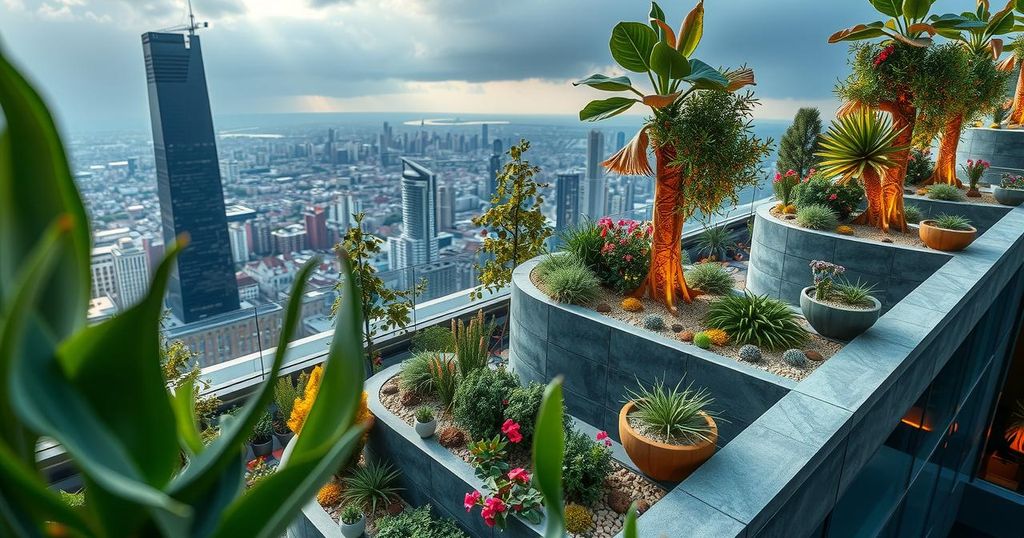The article emphasizes the urgent need for climate resilience in India due to extreme weather events causing significant casualties and crop damage. It advocates for terrace and balcony gardens as an effective response, capable of reducing urban temperatures, enhancing air quality, and contributing to ecological stability. Adopting policies to support green roofs and gardens could help urban areas combat climate challenges while fostering community engagement and biodiversity.
The Climate India 2024 report by the Centre for Science and Environment reveals a grave crisis affecting India, as extreme weather events have occurred almost daily, resulting in over 3,000 fatalities and devastating approximately 3.2 million hectares of crops. This alarming trend has impacted nearly all states and Union territories, highlighting the urgent need for adaptive responses to climate challenges, particularly in urban environments.
Urban communities, especially those with essential outdoor workers or residents in transient housing, face heightened risks from extreme temperatures. Cities are increasingly pressured as temperatures rise, leading to overwhelmed infrastructure and healthcare systems. Despite state governments implementing night shelters, adjusting school hours, and conducting awareness campaigns, these interventions are inadequate in addressing the escalating climate crisis.
As a solution, urban areas are increasingly turning to green initiatives like terrace and balcony gardens. Research indicates that incorporating vegetation into urban landscapes can contribute significantly to mitigating climate extremes. Globally, cities such as Copenhagen have seen transformative results from promoting green roofs and community-maintained green spaces, creating cooler urban environments and fostering community engagement.
Terrace and balcony gardens offer multiple advantages, especially during heat waves, which have intensified in Indian cities. Vegetative coverage reduces surrounding temperatures through natural shading and evapotranspiration, with studies showing a potential surface temperature reduction of up to 20°C. This cooling not only enhances air quality but also reduces energy demands, as less air conditioning is required, thereby indirectly lowering greenhouse gas emissions.
In addition to temperature regulation, these green spaces offer significant insulation benefits in colder months by retaining warmth and minimizing the need for indoor heating. Green roofs can also serve as windbreaks, creating a more stable indoor climate year-round. Furthermore, they help establish small ecosystems that promote biodiversity by attracting beneficial insects, birds, and pollinators, enhancing ecological resilience within urban environments.
These gardens can act as community hubs, allowing neighbors to exchange gardening advice, share seeds, and collaborate on sustainable practices, thus fostering a sense of community and shared purpose regarding environmental stewardship.
India’s metropolitan regions have a significant opportunity to emerge as pioneers in adopting greener urban frameworks for climate adaptation. To facilitate the proliferation of terrace and balcony gardens, policymakers should consider adjusting building regulations to promote green roofs in new developments and provide financial incentives for households to retrofit existing structures with greenery.
With proper government support, terrace and balcony gardens could become commonplace in Indian urban landscapes, representing a low-cost but high-impact strategy against climate change challenges. The expansion of these initiatives would not only enhance city aesthetics but also fortify urban environments against the adverse effects of rising temperatures and erratic weather patterns.
In conclusion, the implementation of terrace and balcony gardens within urban planning presents a valuable opportunity for India to adopt sustainable practices that combat climate extremes while fostering a healthier living environment. By promoting the integration of greenery into city designs, India can create resilient urban areas capable of withstanding the forthcoming climate challenges.
The article discusses the urgent climate crisis in India, highlighting the recent spate of extreme weather events that have led to significant fatalities and agricultural losses. Urban areas, especially, are highlighted as critical battlegrounds due to their vulnerability to rising temperatures and poor infrastructure. The text emphasizes the potential for green solutions, particularly terrace and balcony gardens, to enhance urban resilience against climate change, drawing on successful examples from other cities around the world. The article also addresses the psychological and environmental benefits of these green spaces, including improved community engagement, biodiversity enhancement, and overall quality of urban life as cities face increasing climate challenges.
In summary, terrace and balcony gardens present a viable and effective means for mitigating the impacts of climate change in urban India. As cities grapple with rising temperatures and extreme weather conditions, adopting green solutions could not only provide immediate relief but also foster community interactions and ecological health. With supportive policies and community involvement, these green initiatives could reshape urban landscapes, making them more resilient, sustainable, and habitable for all residents.
Original Source: www.downtoearth.org.in







